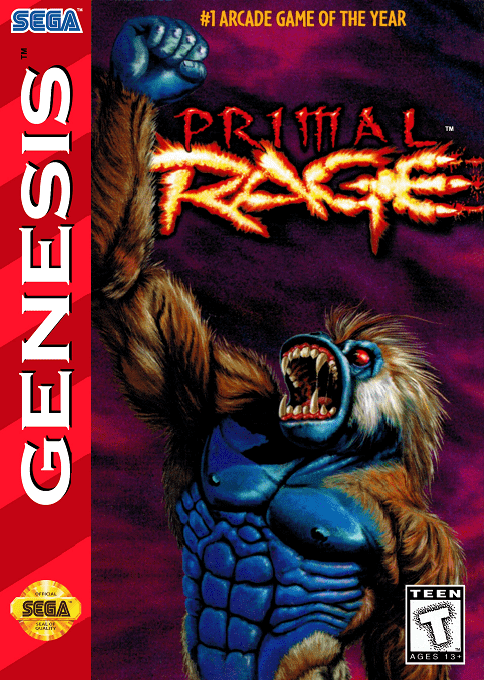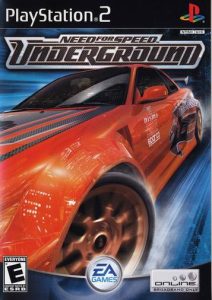Primal Rage
Primal Rage is a fighting game developed and released by Atari Games to arcades in the year 1994. The game takes place on a post-apocalyptic version of Earth called “Urth”. Players control one of seven large beasts that battle each other to determine the planet’s fate.
Matches feature many of the conventions of fighting games from the era, including special moves and gory finishing maneuvers. Ports were released for home consoles and personal computers. Efforts to perfectly emulate the arcade original have been unsuccessful due to the use of an unusual copy protection method. Toys, comics, a novel and other merchandise tie-ins were produced. The game sold more than 1.5 million copies.[3]
Gameplay – Primal Rage

Primal Rage is a traditional two-dimensional fighting game in which two players select characters to battle each other in one-on-one combat, or a single player is faced with a campaign of fights against the artificial intelligence (AI) over increasing difficulty.[4] The final battle of the single-player game (accessible only at difficulty level 10 or higher) consists of fighting all the other AI monsters with an increased power bar, made available in a minigame prior to the fight. A total of seven characters are playable. Each character has their own specialized set of three attack moves and abilities.
The object is to deplete the opposing character’s health meter before the player’s own runs out. There are also seven different background stages where fighting takes place, each one representing one of the character’s innate domains: the Cliff (Blizzard), the Hollows (Armadon), the Strip (Talon), the Cove (Sauron), the Ruins (Chaos), the Tomb (Vertigo) and the Inferno (Diablo).
During fights, human tribesmen wander nearby and worship their gods. This allows for the creatures to toss them around or devour some to regain health (eating opponents’ worshipers adds a bonus to one’s score, while eating one’s own will penalize the player). Prior to the final battle, a minigame commences in which the player is given the chance to eat as many worshippers as possible to increase health for the endurance round. Two human-controlled characters can trigger easter egg minigames of human volleyball and bowling.
Unlike most fighting games, where the special moves are performed by moving the joystick followed by pressing one or more buttons, Primal Rage features a system where the player holds down certain buttons, then performs the joystick movements. Later revisions of the arcade game added the ability to perform special moves in the more traditional way, with motion followed by button presses, but kept the original method as well.
After the opponent is defeated, a brief moment is allowed for the player to perform a finishing move to end the match in a more dramatic fashion; these are performed in a similar manner to the special moves. Although all characters feature three finishing moves, some of them are more easter eggs than fatalities, such as Vertigo’s “La Vache Qui Rit” (French for “the laughing cow”), a fatality in which Vertigo transforms her opponent into a cow, which moos and runs away.
Plot – Primal Rage
A massive meteor strike has devastated Earth. Human civilization comes to an end in the ensuing cataclysms and humanity regresses into tribes of Stone Age dwellers. A primordial rainforest covers the land and the continental landmass has shifted into the shape of a fire-breathing dinosaur skull. The planet is now primitively referred to as “Urth” by the survivors of the cataclysms.
Seven fearsome creatures with supernatural abilities emerge from their slumber deep within the Urth’s crust, and become worshiped as gods by the humans, who form segregated clans beneath the ones they follow. The beasts themselves are divided between those who wish to keep peace on Urth, and those who attempt to plunge the world into further chaos for their own benefit.
These creatures are Blizzard, the ape-like god of good; Armadon, the ceratopian/thyreophoran-like god of life; Talon, the raptor-like god of survival; Sauron, the tyrannosaur-like god of hunger; Chaos, the ape-like god of decay; Vertigo, the cobra-like goddess of insanity and Diablo, the tyrannosaur-like god of evil.
Development – Primal Rage
Animator Jason Leong recounted:
Every year [Time Warner Interactive] throws a brain-storming session where everybody brings up new game ideas. A few years ago I brought up the concept of a head-to-head dinosaur fighting game, which coincidentally someone else also brought up, but their idea was just two T. Rexes fighting. My original write-up included ideas that finally appeared in the game, such as different species of quickly moving dinosaurs and the concept of the dinosaurs being gods.[5]
The game’s development began with a series of production sketches of the fighters drawn by Leong.[5][6] Using these drawings as a basis, model maker Dan Platt crafted model figures of the fighters, from which flexible metal armatures were then cast.[6]
The models were airbrushed according to Leong’s drawings. The animations seen in the game were then filmed using these models, through the process of stop-motion animation, with about 400 frames shot for each fighter.[6] Production coordinator Stephen Riesenberger says the game was designed to be accessible to novices, with its four-button controls being less daunting than the standard six-button layout, and unusual special move inputs making it easier to perform the attacks by button mashing.[7]
Release – Primal Rage
Primal Rage was released for arcades by Time Warner Interactive during August 1994.[8] The game was released in two variants: a standard 25″ cabinet and a deluxe 33″ cabinet.[9] Commercial ports of the title include: 3DO Interactive Multiplayer, 32X, Amiga, Atari Jaguar CD, Game Boy, Game Gear, MS-DOS, PlayStation, Sega Genesis, Sega Saturn and Super Nintendo Entertainment System.[9][10][11] To promote the home versions, Time Warner Interactive hosted a “National Primal Rage Video Game Tournament” at Six Flags Over Texas in October 1995.[12]
A Mac OS port was also planned to be published on November 14, 1995[11] and advertised in Macworld‘s January 1996 issue.[13] However, development on the conversion was cancelled in April of the same year.[14]
Primal Rage was ported to the Game Boy by Probe Software and released in both North America and Europe on August 25, 1995.[10][15] This port excluded Vertigo from the roster and features a reduced moveset for every character and downgraded visuals.[4][10] The Game Gear port is similar to the Game Boy release but with color graphics, much of the blood and gore retained and the “urination” fatality intact.[4] This port has smaller sprites, less vibrant colors, and a cheat code that replaces Diablo’s followers with Fergus McGovern, former CEO and founder of Probe Software.[4][10] Prior to launch, a limited version was available for Sega Channel subscribers while a different version was released through the service on August 26, 1995, with twenty-four percent of subscribers taking part in the event to receive an 800 number and win prizes.[16]
The SNES port, developed by Bitmasters and released in both North America and Europe on August 25, 1995,[10][17] has more detailed visuals compared to the Genesis release; however, Chaos’ golden shower fatality was censored.[4][18] The MS-DOS port, developed by Teeny Weeny Games, features a special setup for keyboard setups and runs at a low resolution.[4]
Primal Rage was ported to the 3DO and published by LG Electronics in both North America and Europe on November 14, 1995,[10][11] featuring a pre-rendered introduction full-motion video sequence and smaller sprites compared to previous releases. The 32X port was developed by Probe Entertainment and first published in North America on November 14, 1995[10][11] and in Europe in March 1996.[19] It is based on the Genesis release but features more arcade-accurate visuals.[4] The Jaguar CD port is similar to the 3DO release, although it lacks the full-motion video introduction[4] and has shorter loading times. The PlayStation port was released in North America and Europe on November 14, 1995,[10][11] and in Japan on December 13, 1996.[20]
It features long loading times and fewer frames of animation for each character than the arcade version. The Amiga port was released only in Europe in December 1995, and features visuals similar to the Genesis release.[4][21] Although marketed as an Amiga 1200 release, this port is compatible is any Amiga computer with a least 2MB of RAM.[22]
The Saturn port was released in North America in June 1996, in Europe in August 1996,[23] and in Japan by GameBank on March 26, 1998,[24] featuring more colors and lager sprites as well as pre-rendered FMV sequences for each character in single-player mode.[4][25] The Saturn version of Primal Rage was the last version to be released. Senior producer Ken Humphries explained, “To be honest, the Saturn version got lost in the shuffle.
In the process of trying to get other versions done, the Saturn version was the one they ended up pulling resources from.”[25] To allow the Saturn version to run at a solid frame rate, the game was made to run at 30 Hz instead of the usual 60 Hz.[25] According to Humphries, it was easier to make the Saturn hardware approximate the size of the arcade version’s sprites than it was with other conversions of the game.[25]
All console versions are based on version 1.7 of the arcade. A largely revised version of the arcade game, version 2.3, was released later in 1994. This version features modified special inputs, balance changes and additional content, such as one additional finisher per character, among many others.[26]
A version of the game based on arcade version 2.3 was included as part of Midway Arcade Treasures 2 for GameCube, PlayStation 2 and Xbox in 2004,[4] later being included as part of Midway Arcade Treasures Deluxe Edition for the PC in 2006.[27]
Reception- Primal Rage
Primal Rage was a major commercial success, although Atari Games derived more profit from its merchandising than from the game itself.[60][61] RePlay reported the game to be the third-most-popular deluxe arcade game at the time.[62] Play Meter also listed the title to be the fourth-most-popular arcade game at the time.[63]
Next Generation reviewed the original arcade version, stating that “All in all, an excellent show of graphics and sound design tarnished by unbalanced gameplay.”[64] AllGame‘s Brad Cook praised the arcade version’s visuals, sound, gameplay and replay value, stating that “This is a fun game and a good value at 25 cents per play with 25 cents to continue.”[65] The title was nominated for the Video Software Dealers Association‘s “Video Game of the Year” for 1995, losing to Donkey Kong Country 2: Diddy’s Kong Quest.[66][67]
 (Demo) (1995-08-01) (Sega Channel) (Test Drive Version)-1024x656.png)
Volcano
Glacier
Shattered City
Jungle Waterfall
Red Beach











